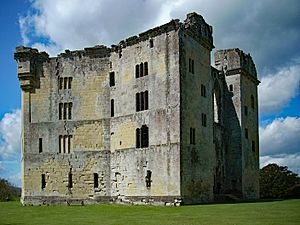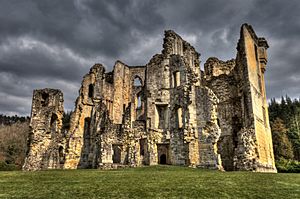Siege of Wardour Castle facts for kids
Quick facts for kids Sieges of Wardour Castle |
|||||||
|---|---|---|---|---|---|---|---|
| Part of the First English Civil War | |||||||
 Ruins of Wardour Castle |
|||||||
|
|||||||
| Belligerents | |||||||
| Commanders and leaders | |||||||
|
First siege Henry Arundell, 3rd Baron Arundell of Wardour |
First siege Edmund Ludlow |
||||||
| Strength | |||||||
| First siege 25 Second siege variable; up to one regiment |
First siege 1,300 Second siege 75 |
||||||
Wardour Castle in Wiltshire, England, was attacked twice during the First English Civil War. The first attack happened in May 1643. The second attack took place between November 1643 and March 1644. These events are known as the Sieges of Wardour Castle.
The English Civil War was a big conflict in England between 1642 and 1651. It was fought between supporters of the King, called the Royalists, and supporters of Parliament, called the Parliamentarians.
Contents
First Attack on Wardour Castle
Wardour Castle was the home of the Arundell family. They were Catholic and strongly supported King Charles. In May 1643, the castle was attacked by Parliamentarian forces.
Lady Arundell's Defense
The owner of the castle, Thomas Arundell, 2nd Baron Arundell of Wardour, was away fighting for the King. So, his wife, Lady Blanche Arundell, led the castle's defense. She was 60 years old. She had only 25 soldiers to help her. There were also about 50 servants and her daughter-in-law with three young children inside the castle.

The Parliamentarian force was much larger, with about 1,300 men. They were led by Sir Edward Hungerford. On May 2, 1643, Hungerford demanded that Lady Arundell surrender the castle. She refused, saying she had a duty to her husband to keep it safe.
The Siege and Surrender
The Parliamentarians began to attack the castle. The siege lasted for six days. On May 8, the Parliamentarians used gunpowder to blow up part of one of the castle walls. This made a big hole in the defenses.
Lady Arundell was offered terms of surrender. At first, she refused because the men would not be safe. But when the Parliamentarians threatened to cause more damage and set the castle on fire, she agreed to surrender.
After the castle was captured, the Parliamentarians took many valuable items. They also held Lady Arundell and her family captive for a short time. The Parliamentarians then left 75 of their own soldiers to guard the castle. These soldiers were led by Colonel Edmund Ludlow.
Second Attack on Wardour Castle
After the first siege, the castle was held by Parliamentarian soldiers. But the Arundell family wanted their home back.
Royalists Try to Reclaim the Castle
Henry Arundell, 3rd Baron Arundell of Wardour, who was the son of Thomas and Blanche, gathered a Royalist force. He wanted to take back Wardour Castle. By November 1643, his forces had surrounded the castle. This was called a blockade, meaning they stopped supplies from getting in or out.

The Parliamentarian soldiers inside the castle, led by Colonel Ludlow, had enough food and supplies for a while. They even got more food by trading with local farmers. Ludlow refused to surrender the castle to the Royalists.
Mining and Final Surrender
The Royalists decided to use a special tactic called mining. This meant digging tunnels under the castle walls. They placed gunpowder in these tunnels. After about three months of digging, the Royalists exploded a mine. This caused a huge explosion that destroyed the west wall of the castle.
The damage made the castle very difficult to defend. A few days later, Ludlow and his men surrendered to the Royalists. The Royalists gave them good terms, promising to treat them well. However, some of the Parliamentarian soldiers were later arrested. Ludlow himself was imprisoned for a short time but was soon released.
What Happened Next
After the second siege, Lord Arundell got his family home back. But the castle was so badly damaged that it could no longer be lived in. To prevent anyone else from using it as a fort, Lord Arundell had the castle "slighted." This means parts of it were deliberately destroyed to make it unusable for military purposes.
The Arundell family moved to another home. Many years later, between 1770 and 1776, a new mansion was built nearby. This new home was called New Wardour Castle. The old Wardour Castle remains a ruin today, showing the scars of the Civil War.


